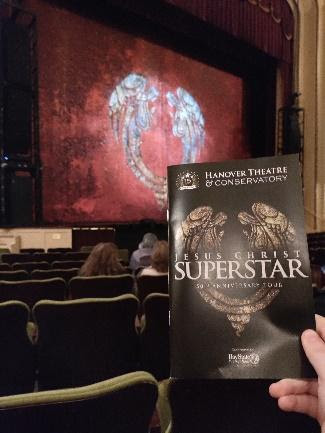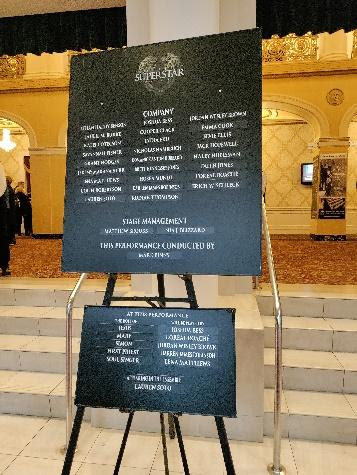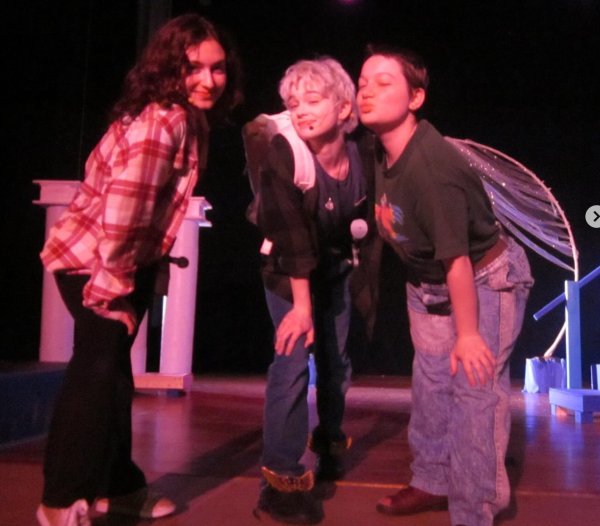Theater Review: In Praise of Jesus Christ Superstar at the Hanover Theater

My obligatory “playbill in front of curtain” picture
Trigger Warning: This musical discusses themes of suicide, suffering, and death.
My obligatory “playbill in front of curtain” picture
On Sunday, April 30th I was fortunate enough to attend the 50th anniversary touring production of Jesus Christ Superstar at the Hanover Theatre. The musical telling the story of Jesus’s human life has been performed countless times and adapted to film: yet it still feels as urgent and new as it did half a century ago due to the innovative and fresh presentation from the talented cast and creative team.


At this performance the lead roles of Jesus, Mary Magdalene and Simon were played by understudies. While the entire cast did great work, the supporting roles were especially strong here: Pontius Pilate (Nicholas Hambruch), the judge who eventually condemns Jesus to death, brings powerful moments of hesitation before sentencing Jesus to die, and the guilt he feels afterward is palpable. In addition, Grant Hodges playing the usually minor role of Caiaphas stands out, not only because of the high priest’s characteristic bass voice, but as embodying the cruel and domineering nature of a man trying to crucify another man. But the most memorable performance of the night was Elvie Ellis as Judas Iscariot, who brought intensity and emotion to every word in the piece and made Judas’s anger feel fresh, utilizing an incredible vocal range to do it. At first, I was a little underwhelmed by understudy Joshua Bess as Jesus, but he quickly won me over with his powerful “Gethsemane,” Jesus’s great confessional ballad shortly before his death. This musical is often presented in a concert format: while here it is a fully staged production, the musicians have been fully incorporated into the set and are situated in booths behind the actors. Hearing the hard-driving rock musicians blare in conjunction with the actors’ vocals proves to make the story immersive.
This production also made itself vivid in its creative decisions: the most striking and visible element to Tom Scutt‘s set design is the large, inverted cross that ends at the front of the stage. At turns it becomes the table for the Last Supper, the judgment hall of the High Priests, and King Herod’s flashy runway. Shades of gold and silver abound through the costumes and set pieces: as Judas reaches to claim his thirty pieces of silver for betraying Jesus, his hands come back tinted in the color and he cannot wipe it away. The colors also emphasize the opulence that Jesus saw as ruining his community: the lashings he receives from Pilate are merely fistfuls of glitter, but the sound snaps along with it to signal severity. The use of microphones was prevalent throughout, with each turn gradually revealing that whoever holds the microphone holds the power in the story. In the reverse point, in moments of death and suffering a red microphone cord would appear: at Judas’s suicide he throws the microphone over a banister, letting it swing back and forth as the chorus intones “Poor Old Judas”.
Perhaps lyricist Tim Rice and composer Andrew Lloyd Webber’s greatest artistic idea for this piece was to portray everyone—Jesus and his persecutors included—as human. This means ending the story with Jesus’s death and imbuing him with doubt and fear beforehand—but it also means giving compassion to characters like Pilate and Judas, who are normally determined to be villains in the Bible and hated as such. This decision, while controversial at first in its 1971 release, is what endears it to theatergoers today: you go and see the tragedy of the common man, two thousand years ago.



